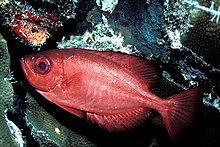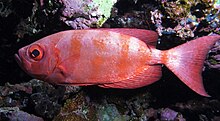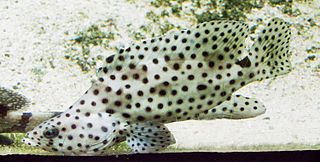
The Serranidae are a large family of fishes belonging to the order Perciformes. The family contains about 450 species in 65 genera, including the sea basses and the groupers. Although many species are small, in some cases less than 10 cm (3.9 in), the giant grouper is one of the largest bony fishes in the world, growing to 2.7 m in length and 400 kg (880 lb) in weight. Representatives of this group live in tropical and subtropical seas worldwide.
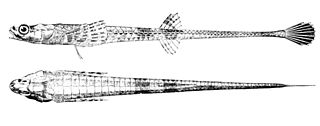
Agonidae is a family of small, bottom-dwelling, cold-water marine fish. Common names for members of this family include poachers, Irish lords, sea ravens, alligatorfishes, starsnouts, hooknoses, and rockheads. They are notable for having elongated bodies covered by scales modified into bony plates, and for using their large pectoral fins to move in short bursts. The family includes about 59 species in some 25 genera, some of which are quite widespread.
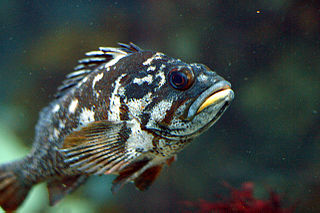
Sebastinae is a subfamily of marine fish belonging to the family Scorpaenidae in the order Scorpaeniformes. Their common names include rockfishes, rock perches, ocean perches, sea perches, thornyheads, scorpionfishes, sea ruffes and rockcods. Despite the latter name, they are not closely related to the cods in the genus Gadus, nor the rock cod, Lotella rhacina.

Sweepers are small, tropical marine perciform fish of the family Pempheridae. Found in the western Atlantic Ocean and Indo-Pacific region, the family contains about 26 species in two genera. One species is the target of subsistence fisheries in Japan, where the fish is much enjoyed for its taste. Sweepers are occasionally kept in marine aquaria.

The Carangidae are a family of ray-finned fish that includes the jacks, pompanos, jack mackerels, runners, trevallies, and scads. It is the largest of the six families included within the order Carangiformes. Some authorities classify it as the only family within that order but molecular and anatomical studies indicate that there is a close relationship between this family and the five former Perciform families which make up the Carangiformes.
Zoarces is a genus of marine ray-finned fishes belonging to the family Zoarcidae, the eelpouts. It is the only genus in the subfamily Zoarcinae. These eelpouts are found in the northern Atlantic and northern Pacific Oceans.
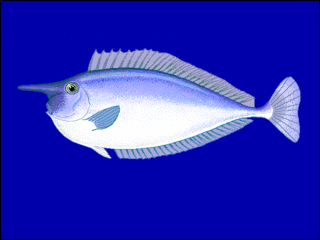
Naso is a genus of marine ray-finned fishes belonging to the family, Acanthuridae, the unicornfishes, surgeonfishes and tangs. The fishes in this genus are known commonly as unicornfishes because of the "rostral protuberance", a hornlike extension of the forehead present in some species. Unicorn fish are popular with spearfishermen and may be cooked by grilling them whole. Unicornfish primarily live around coral reefs and eat mostly algae. It is very popular in Maldives.
Catalufa is the common name for three species of fish belonging to the family Priacanthidae:
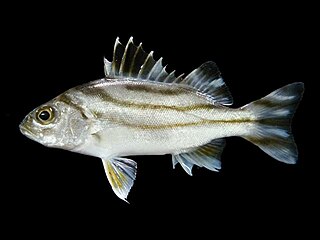
Grunters or tigerperches are ray-finned fishes in the family Terapontidae. This family is part of the superfamily Percoidea of the order Perciformes.

Heteropriacanthus, the glasseyes or glass bigeyes, are a genus of the bigeye family found in all tropical seas around the world. It occasionally makes its way into the aquarium trade. It grows to a size of 50.7 cm (20.0 in) in total length.

The popeye catalufa, also known as the bigeye soldierfish, is a species of marine ray-finned fish in the family Priacanthidae, the bigeyes. This fish has an overall dusky orange to red colour with white markings. The dorsal fin appears feathery while rest of fins have black margins. It occurs in the eastern Pacific, where it is found from Oregon to Chile. It occasionally makes its way into the aquarium trade. It grows to a size of 34 centimetres (13 in) in length. This species is nocturnal and shy, preferring deeper waters off islands. It has been recorded associating with squirrelfishes and cardinalfishes but the popeye catalufa goes as deep as 76 metres (249 ft), deeper than its associated species. This species has been recorded from rocky habitats at depths of less than 5 metres (16 ft) to over 100 metres (330 ft). It is a carnivorous species and, when kept in captivity, is known to feed on worms, crustaceans and brittle stars.

Pristigenys alta, the toro or short bigeye, is a species of fish in the family Priacanthidae. Some anglers refer to this fish as "toro snapper", but it is not a snapper, and only distantly related to the fish of the snapper family.
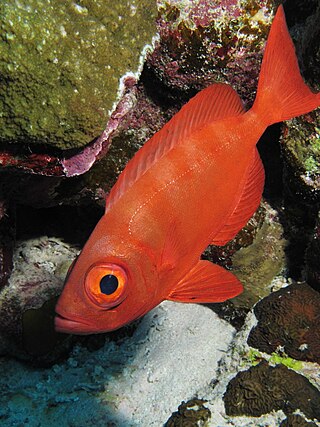
Priacanthus hamrur, the lunar-tailed bigeye, goggle eye, or moontail bullseye, is a species of marine fishes belonging to the family Priacanthidae.
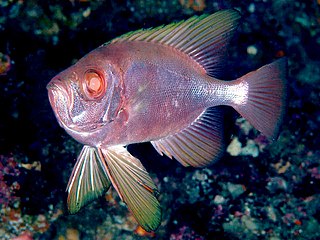
Cookeolus japonicus is a species of fish in the family Priacanthidae, the bigeyes and catalufas. It is the only extant species of Cookeolus, except for C. spinolacrymatus, an extinct Late Pliocene fish known from a fossil specimen collected in Okinawa, Japan.

Pristigenys is a genus of marine ray-finned fish in the family Priacanthidae. It contains five extant species and one extinct species, P. substriata, which is known from fossils found in the Eocene of Monte Bolca, Italy.

Pristigenys niphonia, the Japanese bigeye, is a species of marine ray-finned fish in the family Priacanthidae. It occurs in the western Pacific Ocean.
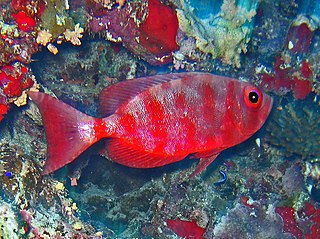
Priacanthus is a genus of marine ray-finned fishes belonging to the family Priacanthidae, the bigeyes. As of 2012 there are 12 species in the genus.

Priacanthus sagittarius, The arrow bulleye, is a species of marine ray finned fish, a bigeye in the family Priacanthidae. It is native to the Indian and Pacific Oceans. It is also observed since 2009, in rare occasions, in the eastern Mediterranean Sea, which it most likely entered via the Suez Canal.

Priacanthus arenatus, the toro or Atlantic bigeye, is a species of marine ray finned fish, a bigeye in the family Priacanthidae. Some anglers refer to this fish as "toro snapper", but it is not a snapper, and only distantly related to the fish of the snapper family. It is found across much of the Atlantic ocean.

Cookeolus is a genus of marine ray-finned fishes from the family Priacanthidae, the bigeyes. It contains one extant species and one extinct species.
